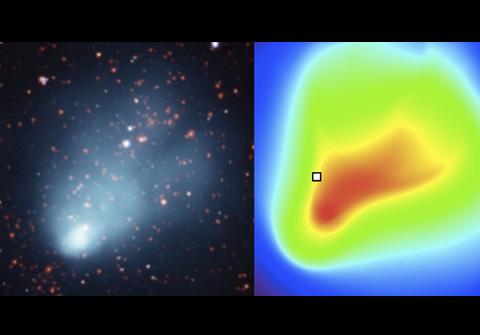Fresh theories about dark matter

An image comparing the data showing the many galaxies and the X-ray emission from the hot gas (left) with the model of the hot gas (right). The Credit: UPV/EHU
Tom Broadhurst, the Ikerbasque researcher in the Department of Theoretical Physics of the UPV/EHU, together with Sandor Molnar of the National Taiwan University and visiting Ikerbasque researcher at the UPV/EHU in 2013, have conducted a simulation that explains the collision between two clusters of galaxies. Clusters of galaxies are the biggest objects that exist in the universe. They are collections of hundreds of thousands of galaxies pulled together by gravity.
In general, galaxy clusters grow in size by merging with each other to become increasingly larger. Gravitational forces cause them to slowly come together over time despite the expansion of the universe. The system known as “El Gordo”, the biggest known cluster of galaxies, is in turn the result of the collision between two large clusters.
It was found that the collision process compresses the gas within each cluster to very high temperatures so that it is shining in the Xray region of the spectrum. In the Xray spectrum this gas cloud is comet shaped with two long tails stretching between the dense cores of the two clusters of galaxies. This distinctive configuration has allowed the researchers to establish the relative speed of the collision, which is extreme (~2200km/second), as it puts it at the limit of what is allowed by current theory for dark matter.
These rare, extreme examples of clusters caught in the act of colliding seem to be challenging the accepted view that dark matter is made up of heavy particles, since no such particles have actually been detected yet, despite the efforts being made to find them by means of the LHC (Large Hadron Particle Collider) accelerator in Geneva and the LUX (Large Underground Xenon Experiment), an underground dark matter detector in the United States.
In Tom Broadhurst's opinion, “it's all the more important to find a new model that will enable the mysterious dark matter to be understood better”. Broadhurst is one of the authors of a wave-dark-matter model published in Nature Physics last year.
This new piece of research has entailed interpreting the gas observed and the dark matter of El Gordo “hydrodynamically” through the development of an in-house computational model that includes the dark matter, which comprises most of the mass, and which can be observed in the Xray region of the visible spectrum because of its extremely high temperature (100 million kelvin).
Dr Broadhurst and Dr Molnar have managed to obtain a unique computational solution for this collision because of the comet-like shape of the hot gas, and the locations and the masses of the two dark matter cores that have passed through each other at an oblique angle at a relative speed of about 2200 km/s. This means that the total energy release is bigger than that of any other known phenomenon, with the exception of the Big Bang.
###
About the author
Tom Broadhurst has a PhD in Physics from the University of Durham (United Kingdom). Until being recruited by Ikerbasque, he had done research at top research centres in the United Kingdom, United States, Germany, Israel, Japan and Taiwan. He has had 184 papers published in leading scientific journals, and so far his work has received 11,800 citations from other scientists. In 2010, he was recruited by Ikerbasque and since then has been carrying out his work at the UPV/EHU's department of Theoretical Physics. His lines of research focus on observational cosmology, dark matter and the formation of galaxies.
Reference: Molnar, SM and Broadhurst, T. Hydrodynamical Solution for the “Twin-Tailed” Colliding Galaxy Cluster “El Gordo” Astrophysical Journal, ApJ 800 37. doi:10.1088/0004-637X/800/1/37
Media Contact
All latest news from the category: Physics and Astronomy
This area deals with the fundamental laws and building blocks of nature and how they interact, the properties and the behavior of matter, and research into space and time and their structures.
innovations-report provides in-depth reports and articles on subjects such as astrophysics, laser technologies, nuclear, quantum, particle and solid-state physics, nanotechnologies, planetary research and findings (Mars, Venus) and developments related to the Hubble Telescope.
Newest articles

NASA: Mystery of life’s handedness deepens
The mystery of why life uses molecules with specific orientations has deepened with a NASA-funded discovery that RNA — a key molecule thought to have potentially held the instructions for…

What are the effects of historic lithium mining on water quality?
Study reveals low levels of common contaminants but high levels of other elements in waters associated with an abandoned lithium mine. Lithium ore and mining waste from a historic lithium…

Quantum-inspired design boosts efficiency of heat-to-electricity conversion
Rice engineers take unconventional route to improving thermophotovoltaic systems. Researchers at Rice University have found a new way to improve a key element of thermophotovoltaic (TPV) systems, which convert heat…



